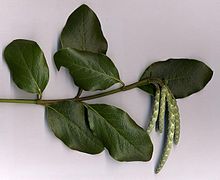- Garrya elliptica
-
Garrya elliptica 
Scientific classification Kingdom: Plantae (unranked): Angiosperms (unranked): Eudicots (unranked): Asterids Order: Garryales Family: Garryaceae Genus: Garrya Species: G. elliptica Binomial name Garrya elliptica
Dougl. ex Lindl.Garrya elliptica (Coast silk-tassel, Silk Tassel Bush or Wavyleaf Silktassel) is a common evergreen shrub native to the coastal ranges of California and southern Oregon, that reaches a height of two to five meters. It is one of a small biological family of approximately twenty known species in the family Garryaceae, most of which are Garrya. All Garrya are associated with warm temperate regions of North America. Female and male sexual organs of all the Garrya are found on separate plants.
Contents
Description
Growth habit
Garrya elliptica, Coast silk-tassel, has a multi-furcate branching structure yielding an almost spherical form. The height can attain five meters-15 feet, but more likely averages three meters-10 feet in the wild. Coast silk-tassel, as all the genus Garrya, have opposite leaves that have a tough leathery feel, glossy green on top, but paler and duller on the underside.
Flowers
The dioecious flowers are concentrated in inflorescences which cascade downward as aments of approximately four to six centimeters in length.[1] While the Coast silk-tassel manifests separate male and female plants, the pendant male catkins are much more showy and are grey-green and up to 30 centimeters long; the female ones are shorter and silver-grey. Although the flowers bloom in January and February, dried bracts remain on the tree well into summer as light gray decorations. The plant has smooth dark bark, dark-greenish when young, but with age the bark roughens. New twigs are green and moderately stout.
For pistillate flowers, above each small bract there is a solitary flower inside the inflorescence. This plant produces tiny dark seeds that can become airborne as small fluffy wind-blown cotton .The ripened purplish black fruit of about one centimeter in diameter has a hard desiccated coating, but is rather fleshy on the interior. In the case of stamenate infloresences, there are a total of four stamens per flower; moreover, above each bract pair there is a triplet of flowers. The cultivar "James roof" has catkins up to 12 inches in length
Leaves
The unique characteristics of Garrya elliptica are its waxy convex leaves with wavy leaf margins, coupled with dense individual hairs on the leaf undersides that are scarcely distinguishable with a hand lens. Its leaf blades are six to eight centimeters in length, and has petioles which range in length from six to twelve millimeters. For identification purposes Congdon silk-tassel (Garrya congdonii) is most closely related. Congdon silk-tassel has the same leaf appearance, but leaf hairs are distinguishable with a hand lens and both leaf blades and petioles are about two thirds the size of Coast silk-tassel. Both Fremont silk-tassel (Garrya fremontii) and Ashy silk-tassel (Garrya flavescens) have similar fruit characteristics, but have a flat leaf margin.
Distribution and habitat
Garrya elliptica is found in several plant communities, principally in drier coastal California and southern Oregon no more than 20 miles from the Pacific Ocean; the main associations are coastal sage and chaparral ecoregion, Northern coastal scrub, Mixed evergreen coastal forest and Northern coastal sage scrub.[2] This plant can tolerate moderately heavy clay soils and serpentine areas, but likes soils pH to lie in the range of six to eight.
This plant is not grazed to a great degree by deer or rabbits, and is hardy to cold temperatures of about 15 degrees Fahrenheit. It is moderately drought tolerant, but is more luxuriant with rainfall of about 25 inches per annum. Coast silk-tassel is usually found at elevations above 200 meters. This species is usually found within the mountains of the Pacific Coast range, such as Montara Mountain, San Bruno Mountain and the coast range in Napa County.
Cultivation
Garrya elliptica is appealing as a ornamental plant with a neat growing habit, and is a widely used Garrya for landscape purposes.[3]
Cultivars include:
- G.elliptica "Evie"
- G.elliptica "James Roof"
References
- ^ Eugene N. Kozloff and Linda H. Reidelman, Plants of the San Francisco Bay Region, Mendocino to Monterey, Sagen Press, Pacific Grove, Ca., Nov. 1994
- ^ Roxana S. Ferris, Native shrubs of the San Francisco Bay region, University of California Press, (1968) ISBN 0-520-00405-1
- ^ Alfred Pink Gardening for the Million. (2004) publisher: Project Gutenberg Literary Archive Foundation
External links
Categories:- Garryales
- Flora of California
- Flora of Oregon
- Drought-tolerant plants
- Garden plants of North America
Wikimedia Foundation. 2010.
